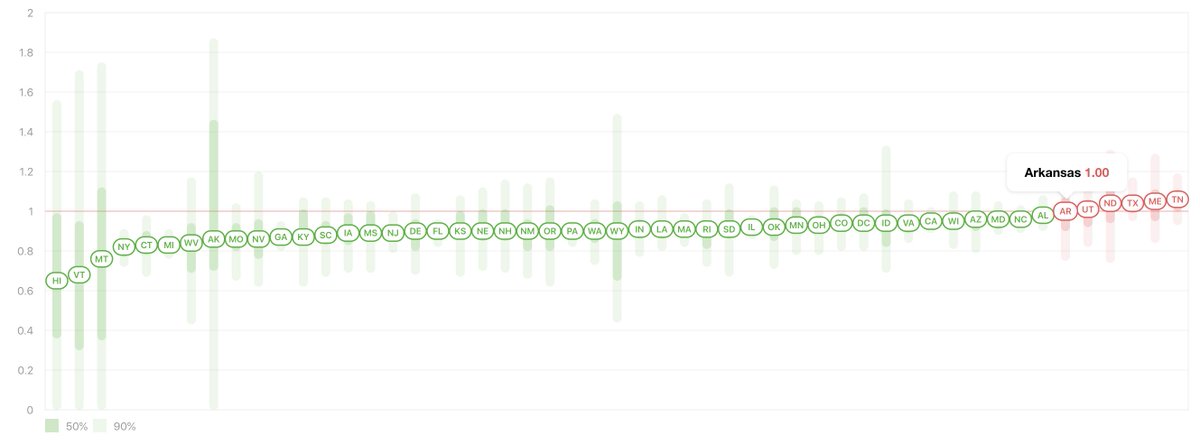Controversial view (& w/the requisite I’m-not-an-epidemiologist preface): If Rt really is approximately 1 in states that are reopening, then that strikes me as a powerful argument for shutting things down longer. Here’s the intuition: 1/
Take Arkansas. Rt = 1.00 per http://rt.live"> http://rt.live . ~187 new cases/day per CDC. Case fatality rate = 2.0%, which might be overestimate of infection fatality rate (denominator excludes unconfirmed cases) or underestimate (numerator excludes already-infected-but-not-yet-dead) 2/
Let’s say IFR = 1.0% (which would be higher than Hubei, but roughly consistent with Hubei age-stratified data mapped onto US age distribution). Let’s (optimistically) assume we’re catching all new cases. Of 187 new cases/day, 1.87 will die 3/
Assume (optimistically) we’re 365 days away from a widely available vaccine. So on pace for 683 deaths of people who are not yet infected. Infections never bring state near herd immunity threshold. This is assuming (optimistically) no big second wave. 4/
Now let’s assume (& we can re-calculate w/different versions of this assumption) that a statewide shelter-in-place order for 2 weeks would reduce the # of new cases by 1/2. After that, return to status quo & Rt ≈ 1. 5/
So now instead of 68,255 more infections in Arkansas, we have half that. Instead of 683 more deaths, we have 341.5. Again, this is assuming a 2-week shelter-in-place period, halving new infections/day, followed by a return to activity consistent w/Rt ≈ 1. 6/
Arkansas’s GDP is about $370 million/day. Let’s assume shelter-in-place order reduces GDP per day by ½. That’s a cost of $1.295 billion to save 341.5 lives, or ~$3.8 million/life, which is very cost-effective by conventional CBA standards 7/
Or to rephrase the intuition w/less math: You’re driving a deadly bundle of metal along the highway at a fast pace. By pressing on the brakes, you can slow it down. What’s the key # that tells you when to release the brakes? It’s not your acceleration; it’s your speed 8/
Here, Rt is an approximate measure of acceleration and new cases/day is a measure of speed. We want to get the car moving slowly (i.e., a low # of new cases/day) before we release the brake, especially if releasing the brake means Rt ≈ 1. 9/
(Thanks in advance to those who have thought about this for many years longer than I have and will explain why this is all wrong.) 10/10
& if you& #39;ve picked up the error in the math above,  https://abs.twimg.com/emoji/v2/... draggable="false" alt="👏" title="Clapping hands sign" aria-label="Emoji: Clapping hands sign">. GDP of $370m/day means the 2-week shutdown costs $2.6 billion, not $1.3 billion, so cost-effectiveness is ~$7.6m/life. Still much better than what EPA considers cost-justified, even w/the controversial "senior discount" 11/10
https://abs.twimg.com/emoji/v2/... draggable="false" alt="👏" title="Clapping hands sign" aria-label="Emoji: Clapping hands sign">. GDP of $370m/day means the 2-week shutdown costs $2.6 billion, not $1.3 billion, so cost-effectiveness is ~$7.6m/life. Still much better than what EPA considers cost-justified, even w/the controversial "senior discount" 11/10

 Read on Twitter
Read on Twitter


